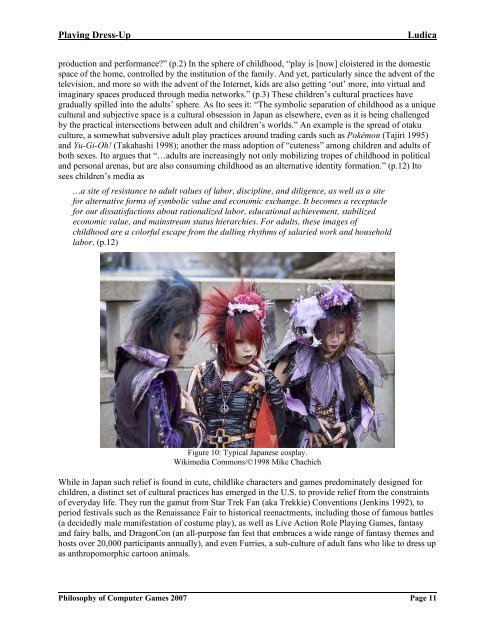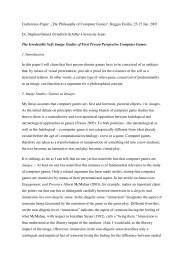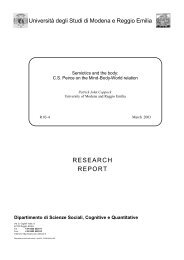Playing Dress-Up: Costumes, roleplay and imagination
Playing Dress-Up: Costumes, roleplay and imagination
Playing Dress-Up: Costumes, roleplay and imagination
You also want an ePaper? Increase the reach of your titles
YUMPU automatically turns print PDFs into web optimized ePapers that Google loves.
<strong>Playing</strong> <strong>Dress</strong>-<strong>Up</strong> Ludica<br />
production <strong>and</strong> performance?” (p.2) In the sphere of childhood, “play is [now] cloistered in the domestic<br />
space of the home, controlled by the institution of the family. And yet, particularly since the advent of the<br />
television, <strong>and</strong> more so with the advent of the Internet, kids are also getting ‘out’ more, into virtual <strong>and</strong><br />
imaginary spaces produced through media networks.” (p.3) These children’s cultural practices have<br />
gradually spilled into the adults’ sphere. As Ito sees it: “The symbolic separation of childhood as a unique<br />
cultural <strong>and</strong> subjective space is a cultural obsession in Japan as elsewhere, even as it is being challenged<br />
by the practical intersections between adult <strong>and</strong> children’s worlds.” An example is the spread of otaku<br />
culture, a somewhat subversive adult play practices around trading cards such as Pokémon (Tajiri 1995)<br />
<strong>and</strong> Yu-Gi-Oh! (Takahashi 1998); another the mass adoption of “cuteness” among children <strong>and</strong> adults of<br />
both sexes. Ito argues that “…adults are increasingly not only mobilizing tropes of childhood in political<br />
<strong>and</strong> personal arenas, but are also consuming childhood as an alternative identity formation.” (p.12) Ito<br />
sees children’s media as<br />
…a site of resistance to adult values of labor, discipline, <strong>and</strong> diligence, as well as a site<br />
for alternative forms of symbolic value <strong>and</strong> economic exchange. It becomes a receptacle<br />
for our dissatisfactions about rationalized labor, educational achievement, stabilized<br />
economic value, <strong>and</strong> mainstream status hierarchies. For adults, these images of<br />
childhood are a colorful escape from the dulling rhythms of salaried work <strong>and</strong> household<br />
labor. (p.12)<br />
Figure 10: Typical Japanese cosplay.<br />
Wikimedia Commons/©1998 Mike Chachich<br />
While in Japan such relief is found in cute, childlike characters <strong>and</strong> games predominately designed for<br />
children, a distinct set of cultural practices has emerged in the U.S. to provide relief from the constraints<br />
of everyday life. They run the gamut from Star Trek Fan (aka Trekkie) Conventions (Jenkins 1992), to<br />
period festivals such as the Renaissance Fair to historical reenactments, including those of famous battles<br />
(a decidedly male manifestation of costume play), as well as Live Action Role <strong>Playing</strong> Games, fantasy<br />
<strong>and</strong> fairy balls, <strong>and</strong> DragonCon (an all-purpose fan fest that embraces a wide range of fantasy themes <strong>and</strong><br />
hosts over 20,000 participants annually), <strong>and</strong> even Furries, a sub-culture of adult fans who like to dress up<br />
as anthropomorphic cartoon animals.<br />
Philosophy of Computer Games 2007 Page 11






